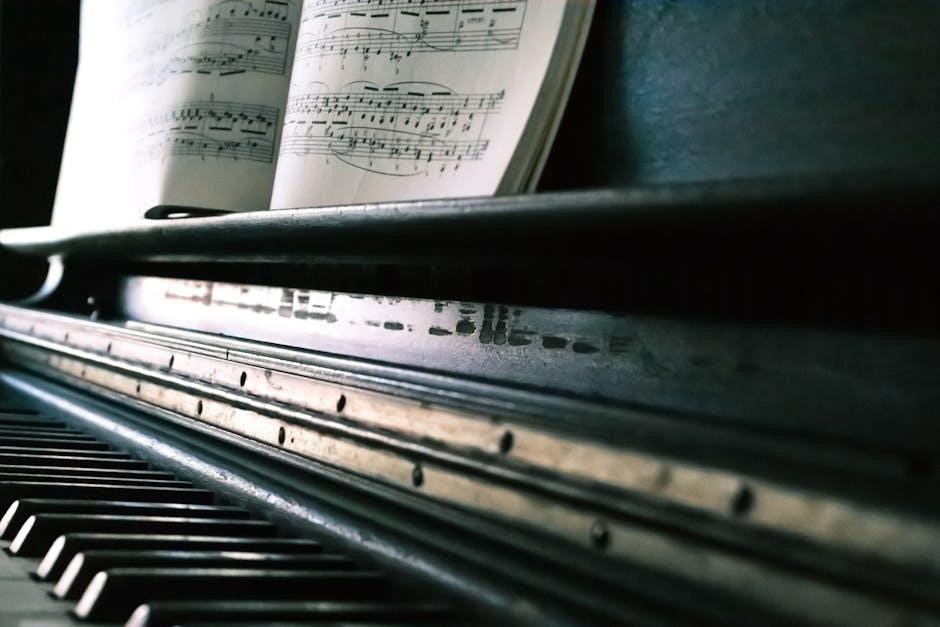slash chords piano pdf
Slash Chords on Piano: A Comprehensive Guide

Are you ready to unlock a new dimension of harmonic possibilities on the piano? This comprehensive guide will delve into the world of slash chords, those intriguing musical symbols that open doors to smoother transitions, walking bass lines and enhanced musical expression․

What are Slash Chords? Definition and Notation
Slash chords, sometimes referred to as “chord over bass” chords, are a unique and valuable tool in music theory and piano playing․ Understanding their definition and notation is crucial for any musician seeking to expand their harmonic vocabulary․
At their core, slash chords are chords that have a bass note that differs from the root of the chord․ They’re written as one chord symbol followed by a slash (/) and then a note name․ For example, C/E represents a C major chord with E as the bass note․
The note to the left of the slash indicates the chord itself, specifying the triad or seventh chord to be played․ The note to the right of the slash indicates the specific bass note that should be played in the left hand․ This bass note alters the overall sound and function of the chord, creating interesting harmonic colors and smooth voice leading․
Slash chords are not inversions in the traditional sense, though they can sometimes function similarly․ Inversions involve rearranging the notes within a chord, while slash chords explicitly dictate a bass note that may or may not be part of the original chord․ This distinction opens up creative possibilities for bass lines and harmonic movement․
By understanding the definition and notation of slash chords, pianists can begin to explore their potential to add depth, sophistication, and a unique flair to their playing․
Understanding Slash Chord Construction: Triad and Bass Note
To truly master slash chords, it’s essential to grasp how they are constructed․ The construction involves two key elements: the triad (or chord) and the bass note․
The first part of a slash chord, the part before the slash, indicates the triad or chord that forms the foundation․ This is typically a major, minor, diminished, or augmented triad, but can also extend to seventh chords and other more complex harmonies․ For example, in the slash chord G/B, the “G” signifies a G major triad, consisting of the notes G, B, and D․
The second part, following the slash, specifies the bass note․ This is the note that should be played in the lowest register, typically by the left hand on the piano․ The bass note can be a note within the triad itself, creating an inversion-like effect, or it can be a note outside the triad, adding a unique color and harmonic movement․ In the G/B example, “B” is the bass note, which is also the third of the G major triad․
When constructing a slash chord, you essentially combine the indicated triad with the specified bass note․ This combination creates a new sonic texture and can alter the function of the chord within a progression․ Understanding this construction allows you to deconstruct and analyze slash chords, as well as create your own unique voicings and arrangements․
Reading Slash Chord Symbols: Chord/Bass Note
Slash chord symbols are a concise way of indicating a chord and its intended bass note․ The symbol follows a simple “Chord/Bass Note” format, where the chord is written before the slash and the desired bass note after it․ Understanding this notation is crucial for interpreting and playing slash chords effectively․
The part before the slash represents the chord itself․ This can be a basic triad like C, G, or Am, or a more complex chord like Dm7, G7, or Cmaj7․ The symbol uses standard chord notation, so familiarity with chord symbols is essential․ For instance, “C” denotes a C major chord, “Am” denotes an A minor chord, and “G7” denotes a G dominant seventh chord․
The part after the slash indicates the specific bass note that should be played․ This bass note is usually a single letter representing a note in the scale, such as C, D, E, F, G, A, or B․ The bass note alters the voicing and potentially the function of the chord, creating interesting harmonic possibilities․
For example, the symbol “C/G” means to play a C major chord with G as the bass note․ Similarly, “Am/E” means to play an A minor chord with E as the bass note․ By deciphering the chord and bass note components, you can accurately interpret and play slash chords from sheet music or chord charts․

The Function of Slash Chords: Smoothing Transitions
Slash chords serve a vital function in music by creating smoother, more elegant transitions between chords․ Rather than abruptly jumping from one chord to another, slash chords provide a stepwise or chromatic movement in the bass line, creating a seamless connection and enhancing the overall musical flow․
One common application is to use slash chords to create a descending or ascending bass line․ For instance, in a progression from C to Am, the slash chord C/B can be inserted to create a descending bass line (C-B-A)․ This stepwise motion in the bass adds interest and sophistication to the progression․
Slash chords also facilitate transitions between chords that don’t share common tones․ By using a slash chord, you can introduce a bass note that acts as a bridge between the two chords, making the transition less jarring․ This is especially useful in progressions with leaps or unusual harmonic movement․
Furthermore, slash chords can be used to create a sense of anticipation or resolution․ For example, a slash chord leading to the tonic chord can create a feeling of resolution, while a slash chord leading away from the tonic can create a sense of tension and anticipation․ The strategic use of slash chords can add depth and emotional nuance to your music․
Creating Walking Bass Lines with Slash Chords
Slash chords are invaluable tools for crafting engaging walking bass lines on the piano․ A walking bass line is a sequence of notes, typically played on the lower register, that moves in a stepwise or melodic fashion, providing a rhythmic and harmonic foundation for the music․
By strategically using slash chords, you can create walking bass lines that connect chords smoothly and add a sense of movement and groove․ The bass note of the slash chord determines the note played in the bass line, allowing you to create a specific melodic contour․
One approach is to use slash chords to create a descending or ascending bass line that spans several chords․ For example, in a progression from C to F, you could use the slash chords C/B, C/Bb, and C/A to create a descending bass line that leads smoothly to the F chord․
Another technique is to use slash chords to create a chromatic walking bass line, where the bass notes move in half-step intervals․ This can add a sophisticated and jazzy feel to your music․ Experiment with different combinations of slash chords and passing tones to create unique and interesting walking bass lines․
Slash Chords and Chord Inversions: A Relationship
Slash chords and chord inversions share a close relationship, as both involve altering the bass note of a chord․ Understanding this relationship can deepen your understanding of harmony and enhance your ability to create interesting voicings on the piano․
A chord inversion occurs when a note other than the root of the chord is in the bass․ For example, a C major chord in first inversion has E in the bass, while a second inversion has G in the bass․
Slash chords can be seen as a way to explicitly specify the bass note, even if it’s not a typical inversion of the chord․ While inversions usually involve notes within the chord itself, slash chords allow you to put any note in the bass, creating a wider range of harmonic possibilities․
For example, C/E could be considered a first inversion of C major, but C/F is not a standard inversion․ Slash chords can be used to create inversions or to add non-chord tones to the bass, offering flexibility in voicing chords and creating smooth bass lines․
Common Slash Chord Progressions: Examples
Slash chords are frequently used to create interesting and smooth chord progressions․ They add a unique flavor to standard progressions and can create a more sophisticated sound․ Here are a few common examples of slash chord progressions that you can experiment with on the piano:
Descending Bass Line: C ⎯ C/B ⎯ Am ⎯ Am/G — F, C/E ⎯ Dm ⎯ G․ This progression uses slash chords to create a descending bass line, adding a sense of movement and direction․
Chromatic Movement: Am — Am/G# — Am/G, Am/F#․ This progression uses chromatic movement in the bass to create a smooth and jazzy feel․
Passing Chords: C ⎯ G/B — Am ⎯ Em/G, F ⎯ C/E — Dm — G ⎯ C․ Here, slash chords are used as passing chords to connect the main chords in the progression, making it more fluid and interesting․
Modal Interchange: C, F/A — Dm ⎯ G/B ⎯ C․ This progression uses slash chords to incorporate chords from different modes, creating a richer and more complex harmonic landscape․
Benefits of Using Slash Chords: Enhanced Expression
Slash chords offer several benefits for piano players, particularly in enhancing musical expression․ One major advantage is the ability to create smoother transitions between chords․ By using a slash chord, you can create a more seamless connection between two chords that might otherwise sound abrupt․ This can lead to a more flowing and melodic sound, making your music more enjoyable to listen to․
Slash chords also provide an easy way to create walking bass lines․ By changing the bass note of a chord, you can create a simple, stepwise bass line that adds movement and interest to your playing․ This technique is commonly used in jazz and blues music, but it can be applied to many other genres as well․
Furthermore, slash chords offer a wider range of harmonic possibilities․ By using a different bass note, you can create a chord that has a completely different feel than the original chord․ This allows you to add more color and variety to your music, making it more expressive and engaging․
How to Play Slash Chords on Piano: Practical Tips
Playing slash chords on the piano doesn’t have to be intimidating․ Here are some practical tips to get you started:
First, understand the notation․ The chord symbol before the slash indicates the chord you’ll play with your right hand, while the note after the slash is the bass note played with your left hand․ Start by practicing the chord and bass note separately before combining them․
Next, focus on smooth transitions․ Use slash chords to create seamless movement between chords by carefully selecting bass notes that lead the ear․ Experiment with different voicings to find what sounds best․
Pay attention to the context of the music․ Slash chords are most effective when they serve a musical purpose, such as creating a walking bass line or adding harmonic color․
Practice regularly with chord charts and songs that use slash chords․ Start with simple examples and gradually work your way up to more complex pieces․ Use online resources like PDFs and video tutorials to deepen your understanding․
Free Resources: Slash Chord Charts and PDFs
To further assist your journey into the world of slash chords, we’ve compiled a list of free resources to help you learn and practice․ These resources include slash chord charts and downloadable PDFs, making it easier to understand and implement slash chords in your playing․
Many websites offer comprehensive chord charts that display various slash chords and their corresponding fingerings on the piano․ These charts are great for quick reference and learning new voicings․
Several PDFs are available for download, providing detailed explanations of slash chord theory, along with examples and exercises․ These PDFs often include diagrams and illustrations to enhance understanding․
Online communities and forums dedicated to piano playing often share free slash chord resources, including chord progressions and song transcriptions․
Don’t hesitate to explore these free resources to expand your knowledge and skills․ With practice and dedication, you’ll soon be able to confidently incorporate slash chords into your piano playing․


